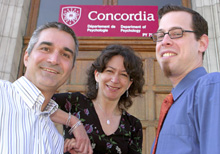Psychologists bring new hope to some sufferers from anxiety

From left, Michel Dugas, Natalie Phillips and Adam Radomsky.
Photo by Andrew Dobrowolskyj
Everyone worries from time to time, but for some people, anxiety becomes so intense that it is paralyzing. Recent research carried out by Concordia’s Michel Dugas has led to a successful new treatment approach for one type of severe anxiety called generalized anxiety disorder (GAD).
“Our treatment manual is being used in several settings in Canada,” said Dugas, naming hospitals in Quebec, Ontario and British Columbia. “We have data showing that this treatment is effective.”
Dugas saw that the relaxation techniques usually used to treat GAD are not completely effective, so he developed an approach that is specific to this disorder. “We want to refine our understanding of the factors involved in the development and maintenance of GAD to help us refine our treatment.”
He is associate professor of psychology and member of the Centre for Research in Human Development, and works with associate professors Natalie Phillips and Adam Radomsky.
With colleagues from Hôpital du Sacré-Coeur de Montréal, where Dugas holds research and clinical positions, they have just received a three-year $156,700 grant from the Canadian Institutes of Health Research to investigate the mechanisms underlying GAD.
Dugas explained that GAD features excessive and uncontrollable worry and anxiety. One of the most common anxiety disorders, it may affect between four and six per cent of the population.
People who suffer from it have difficulty interacting with family and friends, are often unemployed, risk developing other medical problems, and cost the health care system four times more than members of the general population.
Several factors seem to be implicated in GAD. Most commonly, people with GAD are unable to tolerate even small amounts of uncertainty.
For example, if an ordinary traveller knows that there is a one-in-2-million chance that the plane he is scheduled to travel on will crash, he will take the risk, but a person with GAD requires guaranteed safety, and might cancel the trip.
Another factor is fear of anxiety. People with GAD believe that being anxious is dangerous. This combination of features leads them to a paradox: they want to approach the situation in order to be more certain what it involves, but they fear the anxiety involved in making that approach.
“They get stuck between wanting to know more, and not wanting to feel more anxiety,” Dugas said.
Uncertainty
One of the key features of the treatment he has developed is that clients learn to increase their tolerance of uncertainty. “When you increase tolerance to uncertainty, it seems people worry less; there seems to be a causal link.”
A third feature of GAD is that these people seem to process information in a different way than most of the population: they tend to see threats in ambiguous situations.
If they see someone waving from the water, for example, they are more likely to think the person is drowning rather than waving hello, or they will think someone running towards them is a mugger.
In the new study, Dugas and his colleagues will use computer tasks to better understand how people with GAD notice and interpret information around them.
“We are also going to look at the interaction between intolerance of uncertainty and fear of anxiety, and how they are related to this biased cognitive processing,” he said.
The study will look at the differences between three groups: people with GAD, people with other types of anxiety disorders, and people from the general population.
Dugas, who grew up in Ottawa, did his PhD at Laval, and came to Concordia in 1998.
He wanted to be a scientist-practitioner because “when you do research, that helps you be a better clinician, and when you see clients, that helps you come up with more clinically relevant ideas.” His work on GAD helps him achieve that goal.